Evidence-Based Hand Hygiene Report: NUR2300, Semester 3, University
VerifiedAdded on 2022/08/27
|14
|3323
|20
Report
AI Summary
This report critically appraises evidence-based practices related to hand hygiene in healthcare, focusing on the reduction of hospital-acquired infections (HAIs). The study investigates the efficacy of the '5 moments of hand hygiene' protocol within acute care settings, using a PICO framework (Population, Intervention, Comparison, Outcome) to formulate a research question. The report synthesizes findings from various electronic databases like Google Scholar, PubMed, and CINAHL, employing specific keywords and inclusion/exclusion criteria to select relevant articles. It utilizes the CASP (Critical Appraisal Skills Programme) tool to assess the validity and relevance of the selected research. The analysis includes a review of studies comparing different hand hygiene interventions, the adherence to WHO recommendations, and strategies to improve compliance among healthcare workers. The report highlights the importance of hand hygiene in preventing infections and suggests recommendations for practice, such as the use of electronic devices and increased educational initiatives to ensure proper handwashing techniques. The conclusion emphasizes the critical role of hand hygiene in creating a safe environment for patients and healthcare professionals, as well as its impact on reducing the rate of hospital-acquired infections. This report is a contribution from a student and is available on Desklib for study purposes.
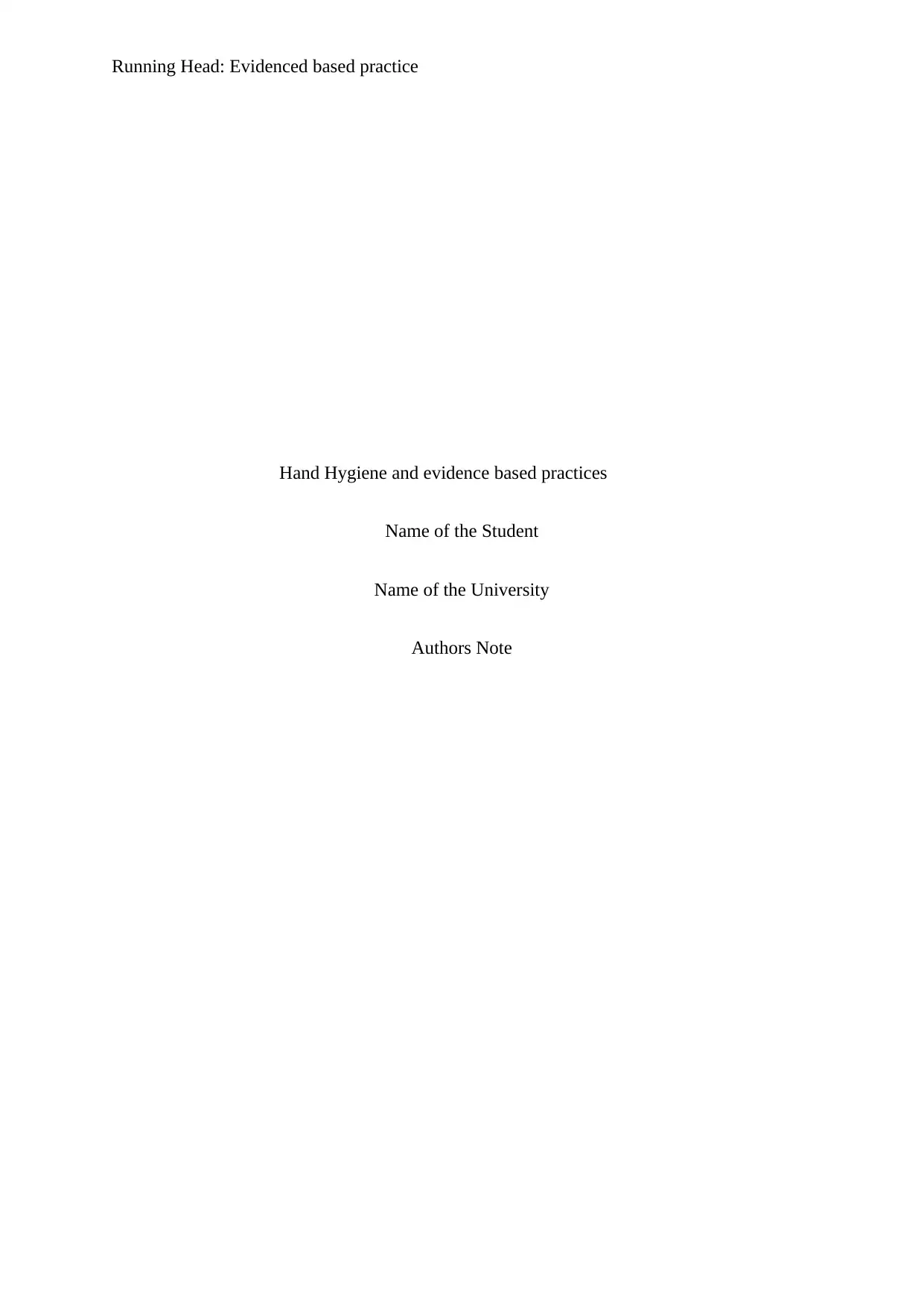
Running Head: Evidenced based practice
Hand Hygiene and evidence based practices
Name of the Student
Name of the University
Authors Note
Hand Hygiene and evidence based practices
Name of the Student
Name of the University
Authors Note
Paraphrase This Document
Need a fresh take? Get an instant paraphrase of this document with our AI Paraphraser
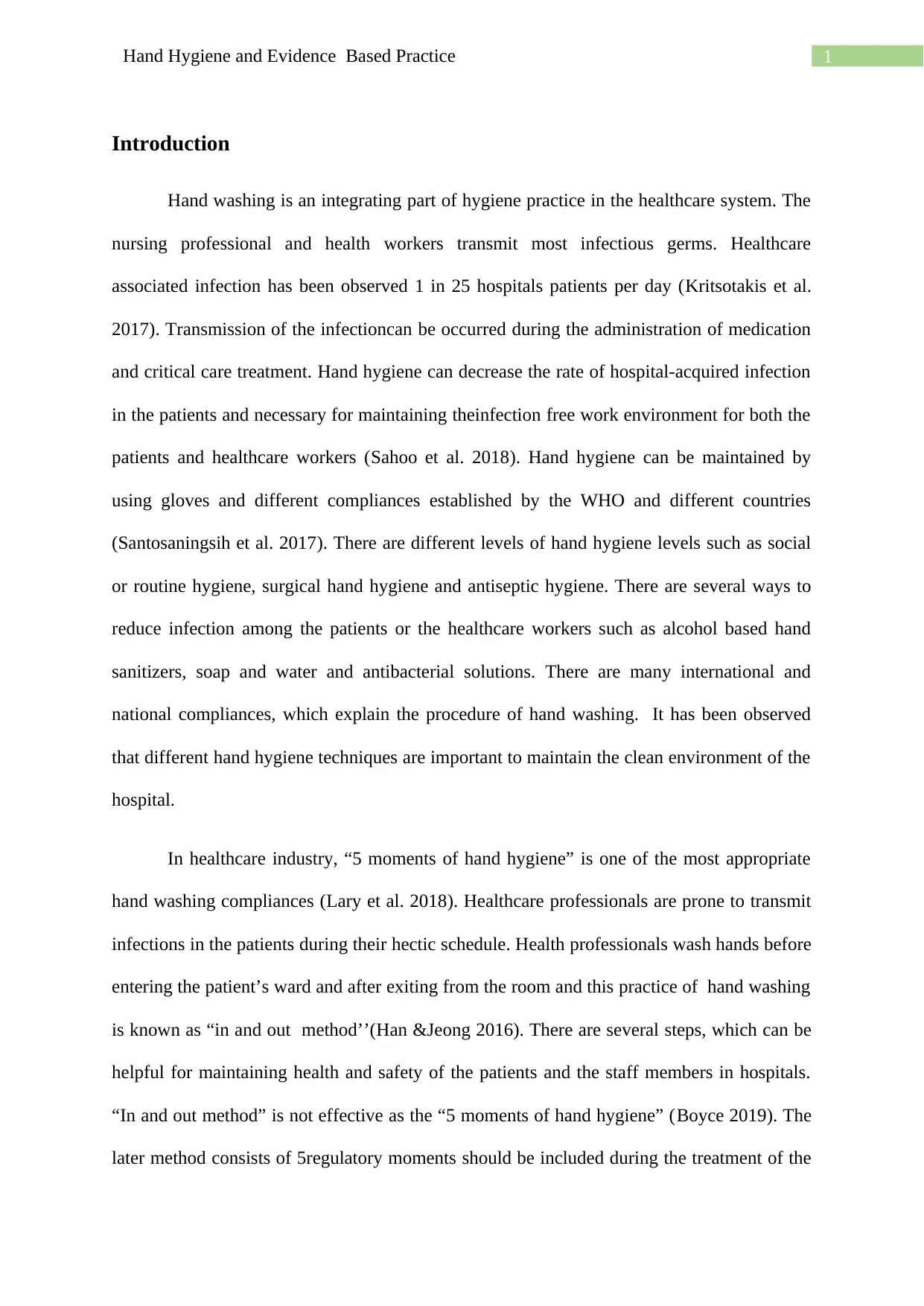
1Hand Hygiene and Evidence Based Practice
Introduction
Hand washing is an integrating part of hygiene practice in the healthcare system. The
nursing professional and health workers transmit most infectious germs. Healthcare
associated infection has been observed 1 in 25 hospitals patients per day (Kritsotakis et al.
2017). Transmission of the infectioncan be occurred during the administration of medication
and critical care treatment. Hand hygiene can decrease the rate of hospital-acquired infection
in the patients and necessary for maintaining theinfection free work environment for both the
patients and healthcare workers (Sahoo et al. 2018). Hand hygiene can be maintained by
using gloves and different compliances established by the WHO and different countries
(Santosaningsih et al. 2017). There are different levels of hand hygiene levels such as social
or routine hygiene, surgical hand hygiene and antiseptic hygiene. There are several ways to
reduce infection among the patients or the healthcare workers such as alcohol based hand
sanitizers, soap and water and antibacterial solutions. There are many international and
national compliances, which explain the procedure of hand washing. It has been observed
that different hand hygiene techniques are important to maintain the clean environment of the
hospital.
In healthcare industry, “5 moments of hand hygiene” is one of the most appropriate
hand washing compliances (Lary et al. 2018). Healthcare professionals are prone to transmit
infections in the patients during their hectic schedule. Health professionals wash hands before
entering the patient’s ward and after exiting from the room and this practice of hand washing
is known as “in and out method’’(Han &Jeong 2016). There are several steps, which can be
helpful for maintaining health and safety of the patients and the staff members in hospitals.
“In and out method” is not effective as the “5 moments of hand hygiene” (Boyce 2019). The
later method consists of 5regulatory moments should be included during the treatment of the
Introduction
Hand washing is an integrating part of hygiene practice in the healthcare system. The
nursing professional and health workers transmit most infectious germs. Healthcare
associated infection has been observed 1 in 25 hospitals patients per day (Kritsotakis et al.
2017). Transmission of the infectioncan be occurred during the administration of medication
and critical care treatment. Hand hygiene can decrease the rate of hospital-acquired infection
in the patients and necessary for maintaining theinfection free work environment for both the
patients and healthcare workers (Sahoo et al. 2018). Hand hygiene can be maintained by
using gloves and different compliances established by the WHO and different countries
(Santosaningsih et al. 2017). There are different levels of hand hygiene levels such as social
or routine hygiene, surgical hand hygiene and antiseptic hygiene. There are several ways to
reduce infection among the patients or the healthcare workers such as alcohol based hand
sanitizers, soap and water and antibacterial solutions. There are many international and
national compliances, which explain the procedure of hand washing. It has been observed
that different hand hygiene techniques are important to maintain the clean environment of the
hospital.
In healthcare industry, “5 moments of hand hygiene” is one of the most appropriate
hand washing compliances (Lary et al. 2018). Healthcare professionals are prone to transmit
infections in the patients during their hectic schedule. Health professionals wash hands before
entering the patient’s ward and after exiting from the room and this practice of hand washing
is known as “in and out method’’(Han &Jeong 2016). There are several steps, which can be
helpful for maintaining health and safety of the patients and the staff members in hospitals.
“In and out method” is not effective as the “5 moments of hand hygiene” (Boyce 2019). The
later method consists of 5regulatory moments should be included during the treatment of the
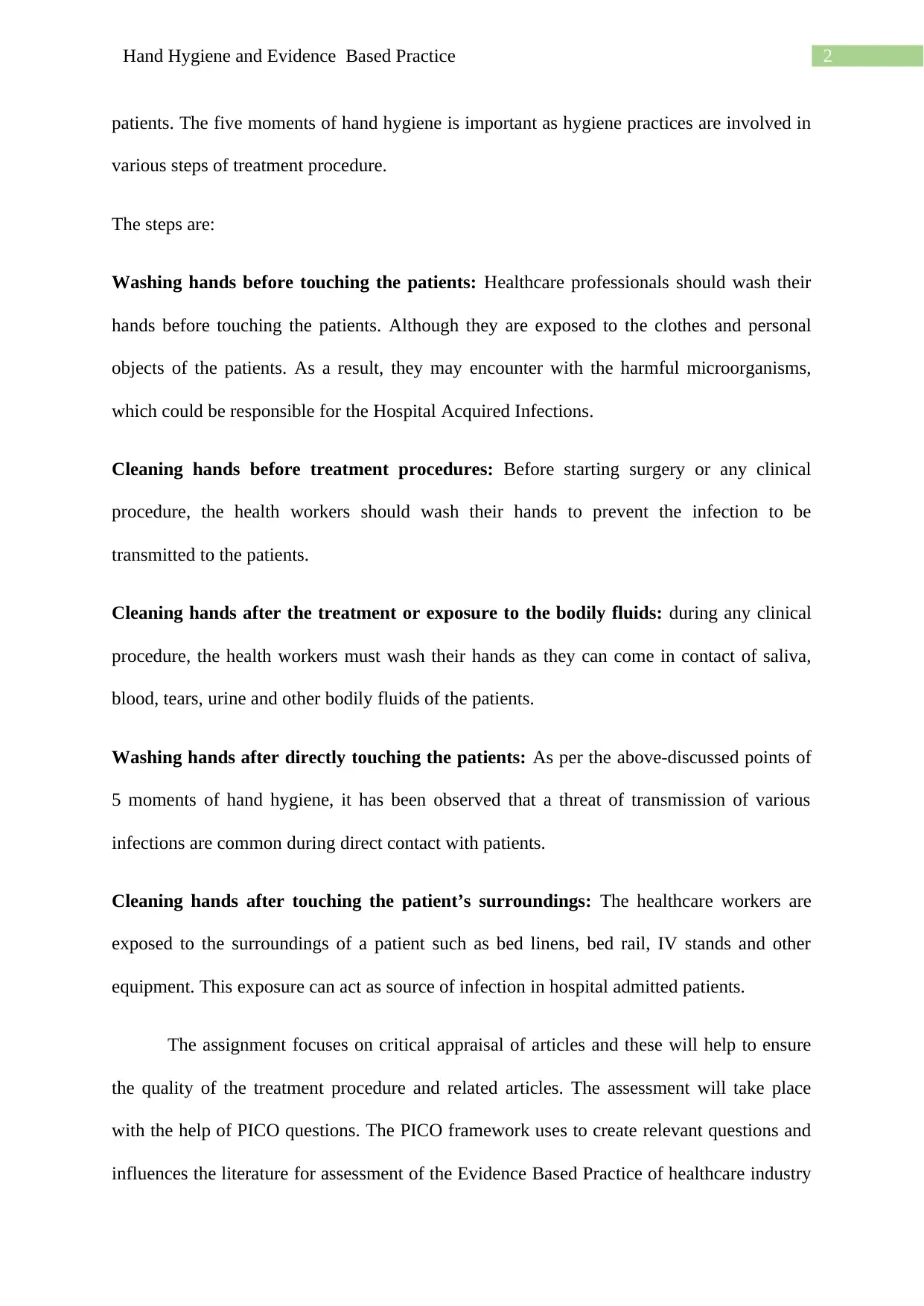
2Hand Hygiene and Evidence Based Practice
patients. The five moments of hand hygiene is important as hygiene practices are involved in
various steps of treatment procedure.
The steps are:
Washing hands before touching the patients: Healthcare professionals should wash their
hands before touching the patients. Although they are exposed to the clothes and personal
objects of the patients. As a result, they may encounter with the harmful microorganisms,
which could be responsible for the Hospital Acquired Infections.
Cleaning hands before treatment procedures: Before starting surgery or any clinical
procedure, the health workers should wash their hands to prevent the infection to be
transmitted to the patients.
Cleaning hands after the treatment or exposure to the bodily fluids: during any clinical
procedure, the health workers must wash their hands as they can come in contact of saliva,
blood, tears, urine and other bodily fluids of the patients.
Washing hands after directly touching the patients: As per the above-discussed points of
5 moments of hand hygiene, it has been observed that a threat of transmission of various
infections are common during direct contact with patients.
Cleaning hands after touching the patient’s surroundings: The healthcare workers are
exposed to the surroundings of a patient such as bed linens, bed rail, IV stands and other
equipment. This exposure can act as source of infection in hospital admitted patients.
The assignment focuses on critical appraisal of articles and these will help to ensure
the quality of the treatment procedure and related articles. The assessment will take place
with the help of PICO questions. The PICO framework uses to create relevant questions and
influences the literature for assessment of the Evidence Based Practice of healthcare industry
patients. The five moments of hand hygiene is important as hygiene practices are involved in
various steps of treatment procedure.
The steps are:
Washing hands before touching the patients: Healthcare professionals should wash their
hands before touching the patients. Although they are exposed to the clothes and personal
objects of the patients. As a result, they may encounter with the harmful microorganisms,
which could be responsible for the Hospital Acquired Infections.
Cleaning hands before treatment procedures: Before starting surgery or any clinical
procedure, the health workers should wash their hands to prevent the infection to be
transmitted to the patients.
Cleaning hands after the treatment or exposure to the bodily fluids: during any clinical
procedure, the health workers must wash their hands as they can come in contact of saliva,
blood, tears, urine and other bodily fluids of the patients.
Washing hands after directly touching the patients: As per the above-discussed points of
5 moments of hand hygiene, it has been observed that a threat of transmission of various
infections are common during direct contact with patients.
Cleaning hands after touching the patient’s surroundings: The healthcare workers are
exposed to the surroundings of a patient such as bed linens, bed rail, IV stands and other
equipment. This exposure can act as source of infection in hospital admitted patients.
The assignment focuses on critical appraisal of articles and these will help to ensure
the quality of the treatment procedure and related articles. The assessment will take place
with the help of PICO questions. The PICO framework uses to create relevant questions and
influences the literature for assessment of the Evidence Based Practice of healthcare industry
⊘ This is a preview!⊘
Do you want full access?
Subscribe today to unlock all pages.

Trusted by 1+ million students worldwide
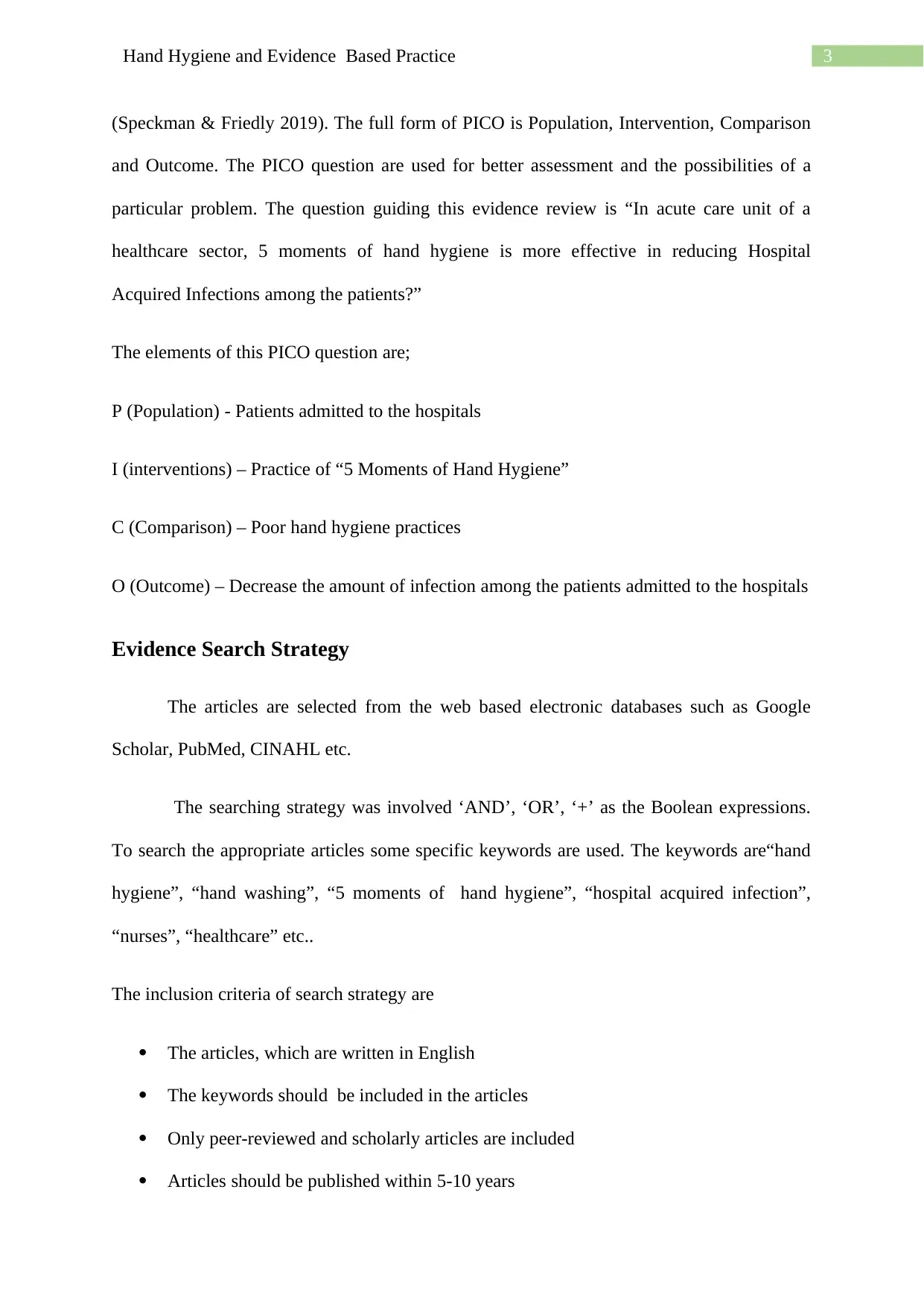
3Hand Hygiene and Evidence Based Practice
(Speckman & Friedly 2019). The full form of PICO is Population, Intervention, Comparison
and Outcome. The PICO question are used for better assessment and the possibilities of a
particular problem. The question guiding this evidence review is “In acute care unit of a
healthcare sector, 5 moments of hand hygiene is more effective in reducing Hospital
Acquired Infections among the patients?”
The elements of this PICO question are;
P (Population) - Patients admitted to the hospitals
I (interventions) – Practice of “5 Moments of Hand Hygiene”
C (Comparison) – Poor hand hygiene practices
O (Outcome) – Decrease the amount of infection among the patients admitted to the hospitals
Evidence Search Strategy
The articles are selected from the web based electronic databases such as Google
Scholar, PubMed, CINAHL etc.
The searching strategy was involved ‘AND’, ‘OR’, ‘+’ as the Boolean expressions.
To search the appropriate articles some specific keywords are used. The keywords are“hand
hygiene”, “hand washing”, “5 moments of hand hygiene”, “hospital acquired infection”,
“nurses”, “healthcare” etc..
The inclusion criteria of search strategy are
The articles, which are written in English
The keywords should be included in the articles
Only peer-reviewed and scholarly articles are included
Articles should be published within 5-10 years
(Speckman & Friedly 2019). The full form of PICO is Population, Intervention, Comparison
and Outcome. The PICO question are used for better assessment and the possibilities of a
particular problem. The question guiding this evidence review is “In acute care unit of a
healthcare sector, 5 moments of hand hygiene is more effective in reducing Hospital
Acquired Infections among the patients?”
The elements of this PICO question are;
P (Population) - Patients admitted to the hospitals
I (interventions) – Practice of “5 Moments of Hand Hygiene”
C (Comparison) – Poor hand hygiene practices
O (Outcome) – Decrease the amount of infection among the patients admitted to the hospitals
Evidence Search Strategy
The articles are selected from the web based electronic databases such as Google
Scholar, PubMed, CINAHL etc.
The searching strategy was involved ‘AND’, ‘OR’, ‘+’ as the Boolean expressions.
To search the appropriate articles some specific keywords are used. The keywords are“hand
hygiene”, “hand washing”, “5 moments of hand hygiene”, “hospital acquired infection”,
“nurses”, “healthcare” etc..
The inclusion criteria of search strategy are
The articles, which are written in English
The keywords should be included in the articles
Only peer-reviewed and scholarly articles are included
Articles should be published within 5-10 years
Paraphrase This Document
Need a fresh take? Get an instant paraphrase of this document with our AI Paraphraser
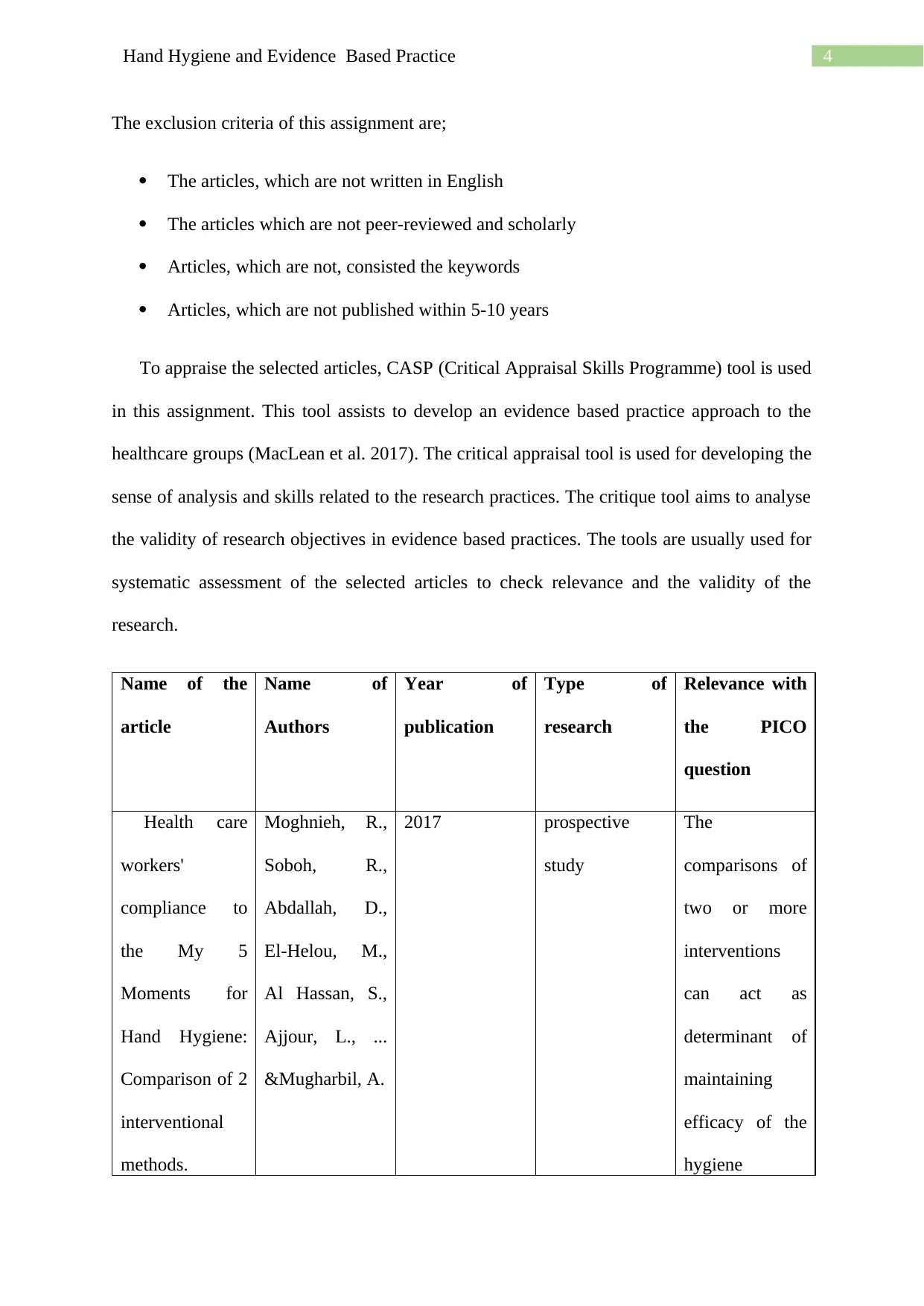
4Hand Hygiene and Evidence Based Practice
The exclusion criteria of this assignment are;
The articles, which are not written in English
The articles which are not peer-reviewed and scholarly
Articles, which are not, consisted the keywords
Articles, which are not published within 5-10 years
To appraise the selected articles, CASP (Critical Appraisal Skills Programme) tool is used
in this assignment. This tool assists to develop an evidence based practice approach to the
healthcare groups (MacLean et al. 2017). The critical appraisal tool is used for developing the
sense of analysis and skills related to the research practices. The critique tool aims to analyse
the validity of research objectives in evidence based practices. The tools are usually used for
systematic assessment of the selected articles to check relevance and the validity of the
research.
Name of the
article
Name of
Authors
Year of
publication
Type of
research
Relevance with
the PICO
question
Health care
workers'
compliance to
the My 5
Moments for
Hand Hygiene:
Comparison of 2
interventional
methods.
Moghnieh, R.,
Soboh, R.,
Abdallah, D.,
El-Helou, M.,
Al Hassan, S.,
Ajjour, L., ...
&Mugharbil, A.
2017 prospective
study
The
comparisons of
two or more
interventions
can act as
determinant of
maintaining
efficacy of the
hygiene
The exclusion criteria of this assignment are;
The articles, which are not written in English
The articles which are not peer-reviewed and scholarly
Articles, which are not, consisted the keywords
Articles, which are not published within 5-10 years
To appraise the selected articles, CASP (Critical Appraisal Skills Programme) tool is used
in this assignment. This tool assists to develop an evidence based practice approach to the
healthcare groups (MacLean et al. 2017). The critical appraisal tool is used for developing the
sense of analysis and skills related to the research practices. The critique tool aims to analyse
the validity of research objectives in evidence based practices. The tools are usually used for
systematic assessment of the selected articles to check relevance and the validity of the
research.
Name of the
article
Name of
Authors
Year of
publication
Type of
research
Relevance with
the PICO
question
Health care
workers'
compliance to
the My 5
Moments for
Hand Hygiene:
Comparison of 2
interventional
methods.
Moghnieh, R.,
Soboh, R.,
Abdallah, D.,
El-Helou, M.,
Al Hassan, S.,
Ajjour, L., ...
&Mugharbil, A.
2017 prospective
study
The
comparisons of
two or more
interventions
can act as
determinant of
maintaining
efficacy of the
hygiene
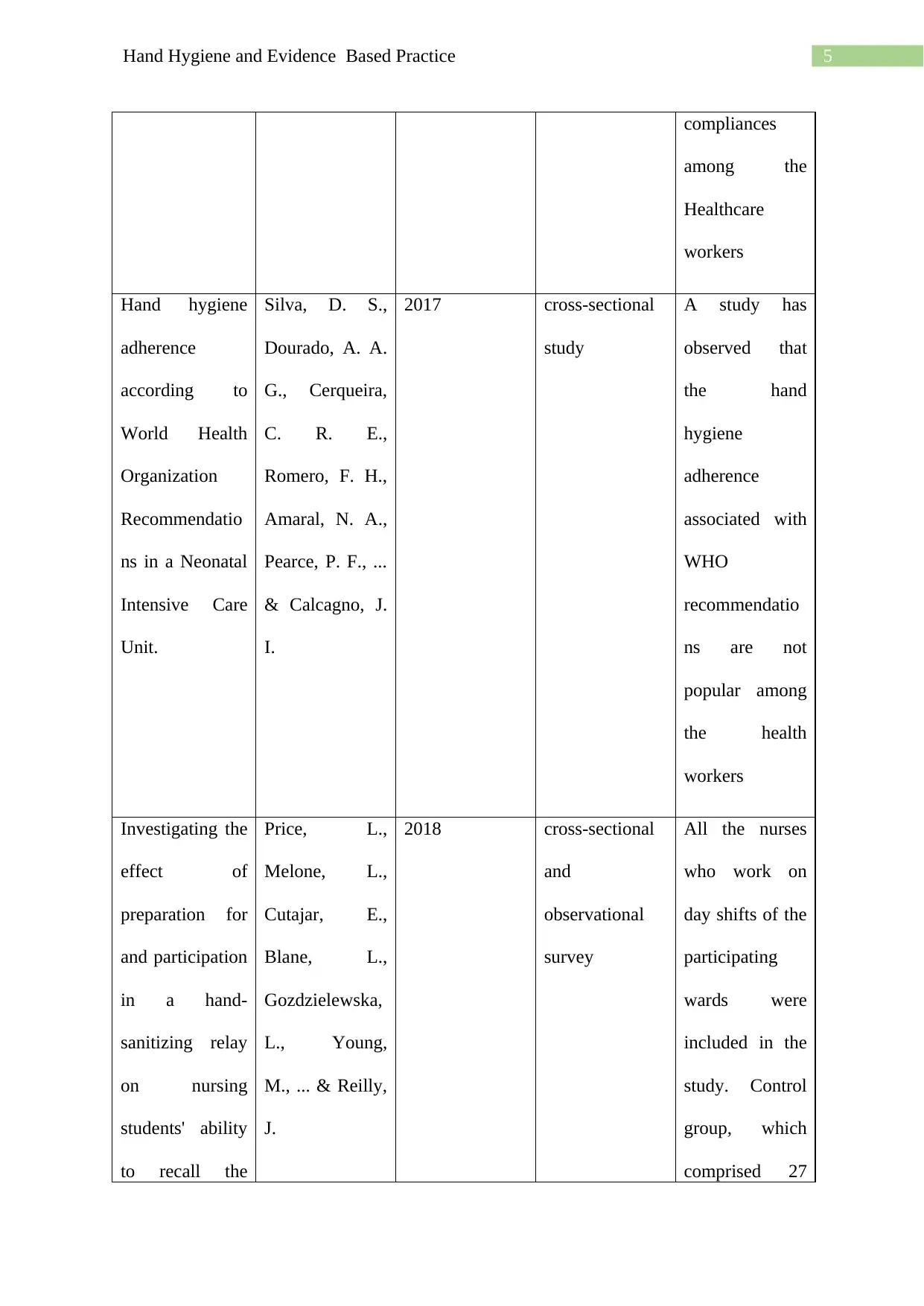
5Hand Hygiene and Evidence Based Practice
compliances
among the
Healthcare
workers
Hand hygiene
adherence
according to
World Health
Organization
Recommendatio
ns in a Neonatal
Intensive Care
Unit.
Silva, D. S.,
Dourado, A. A.
G., Cerqueira,
C. R. E.,
Romero, F. H.,
Amaral, N. A.,
Pearce, P. F., ...
& Calcagno, J.
I.
2017 cross-sectional
study
A study has
observed that
the hand
hygiene
adherence
associated with
WHO
recommendatio
ns are not
popular among
the health
workers
Investigating the
effect of
preparation for
and participation
in a hand-
sanitizing relay
on nursing
students' ability
to recall the
Price, L.,
Melone, L.,
Cutajar, E.,
Blane, L.,
Gozdzielewska,
L., Young,
M., ... & Reilly,
J.
2018 cross-sectional
and
observational
survey
All the nurses
who work on
day shifts of the
participating
wards were
included in the
study. Control
group, which
comprised 27
compliances
among the
Healthcare
workers
Hand hygiene
adherence
according to
World Health
Organization
Recommendatio
ns in a Neonatal
Intensive Care
Unit.
Silva, D. S.,
Dourado, A. A.
G., Cerqueira,
C. R. E.,
Romero, F. H.,
Amaral, N. A.,
Pearce, P. F., ...
& Calcagno, J.
I.
2017 cross-sectional
study
A study has
observed that
the hand
hygiene
adherence
associated with
WHO
recommendatio
ns are not
popular among
the health
workers
Investigating the
effect of
preparation for
and participation
in a hand-
sanitizing relay
on nursing
students' ability
to recall the
Price, L.,
Melone, L.,
Cutajar, E.,
Blane, L.,
Gozdzielewska,
L., Young,
M., ... & Reilly,
J.
2018 cross-sectional
and
observational
survey
All the nurses
who work on
day shifts of the
participating
wards were
included in the
study. Control
group, which
comprised 27
⊘ This is a preview!⊘
Do you want full access?
Subscribe today to unlock all pages.

Trusted by 1+ million students worldwide
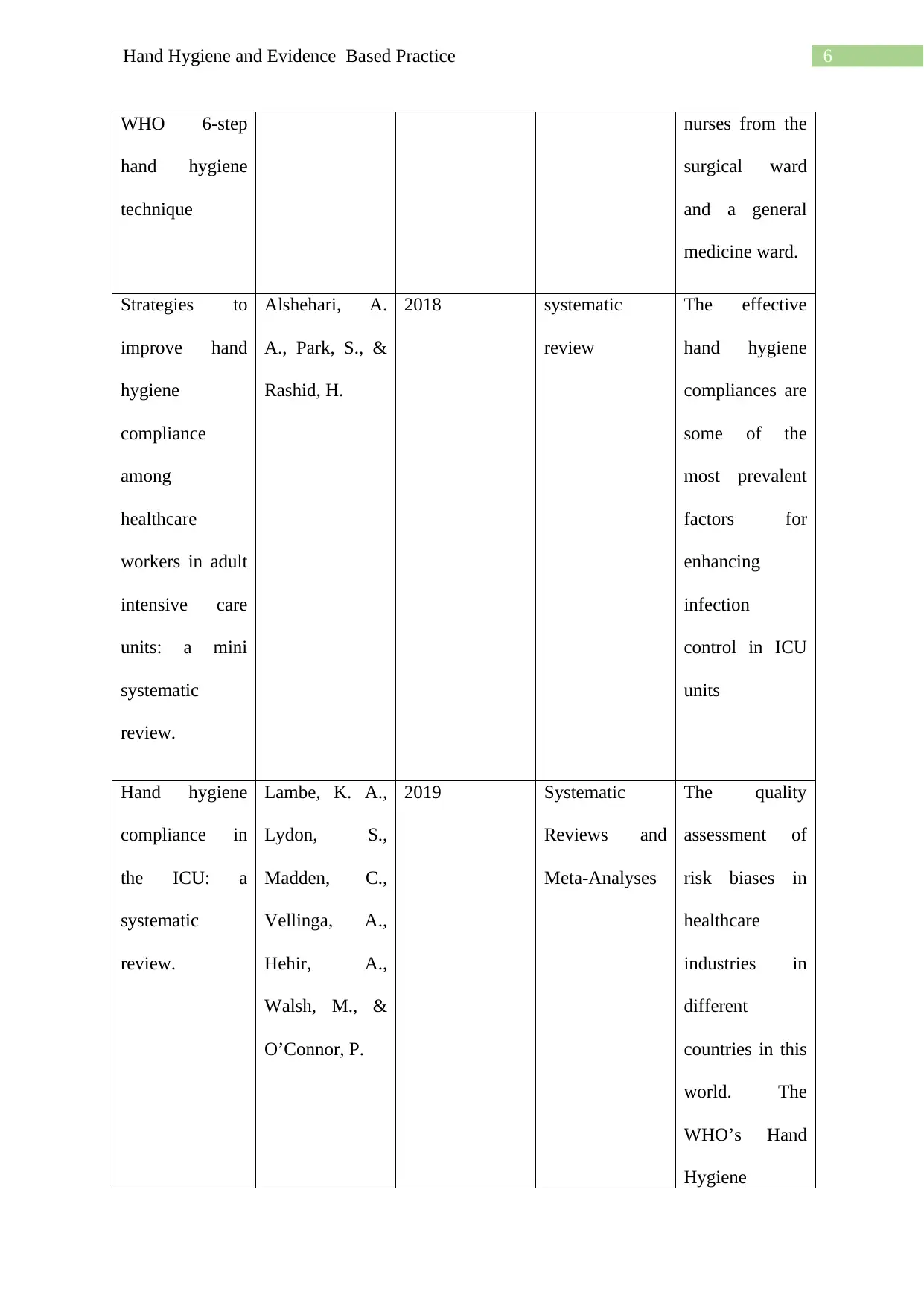
6Hand Hygiene and Evidence Based Practice
WHO 6-step
hand hygiene
technique
nurses from the
surgical ward
and a general
medicine ward.
Strategies to
improve hand
hygiene
compliance
among
healthcare
workers in adult
intensive care
units: a mini
systematic
review.
Alshehari, A.
A., Park, S., &
Rashid, H.
2018 systematic
review
The effective
hand hygiene
compliances are
some of the
most prevalent
factors for
enhancing
infection
control in ICU
units
Hand hygiene
compliance in
the ICU: a
systematic
review.
Lambe, K. A.,
Lydon, S.,
Madden, C.,
Vellinga, A.,
Hehir, A.,
Walsh, M., &
O’Connor, P.
2019 Systematic
Reviews and
Meta-Analyses
The quality
assessment of
risk biases in
healthcare
industries in
different
countries in this
world. The
WHO’s Hand
Hygiene
WHO 6-step
hand hygiene
technique
nurses from the
surgical ward
and a general
medicine ward.
Strategies to
improve hand
hygiene
compliance
among
healthcare
workers in adult
intensive care
units: a mini
systematic
review.
Alshehari, A.
A., Park, S., &
Rashid, H.
2018 systematic
review
The effective
hand hygiene
compliances are
some of the
most prevalent
factors for
enhancing
infection
control in ICU
units
Hand hygiene
compliance in
the ICU: a
systematic
review.
Lambe, K. A.,
Lydon, S.,
Madden, C.,
Vellinga, A.,
Hehir, A.,
Walsh, M., &
O’Connor, P.
2019 Systematic
Reviews and
Meta-Analyses
The quality
assessment of
risk biases in
healthcare
industries in
different
countries in this
world. The
WHO’s Hand
Hygiene
Paraphrase This Document
Need a fresh take? Get an instant paraphrase of this document with our AI Paraphraser
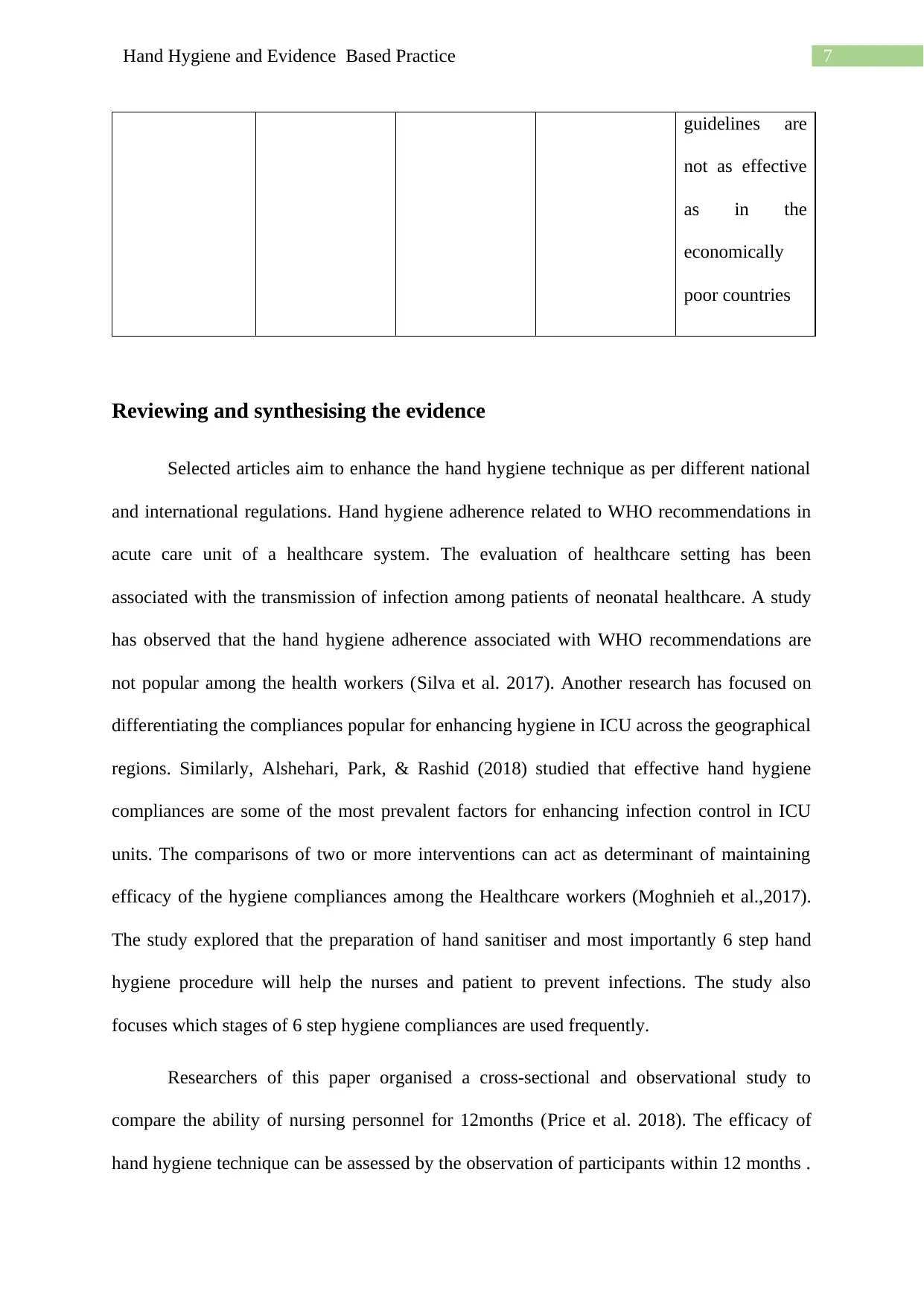
7Hand Hygiene and Evidence Based Practice
guidelines are
not as effective
as in the
economically
poor countries
Reviewing and synthesising the evidence
Selected articles aim to enhance the hand hygiene technique as per different national
and international regulations. Hand hygiene adherence related to WHO recommendations in
acute care unit of a healthcare system. The evaluation of healthcare setting has been
associated with the transmission of infection among patients of neonatal healthcare. A study
has observed that the hand hygiene adherence associated with WHO recommendations are
not popular among the health workers (Silva et al. 2017). Another research has focused on
differentiating the compliances popular for enhancing hygiene in ICU across the geographical
regions. Similarly, Alshehari, Park, & Rashid (2018) studied that effective hand hygiene
compliances are some of the most prevalent factors for enhancing infection control in ICU
units. The comparisons of two or more interventions can act as determinant of maintaining
efficacy of the hygiene compliances among the Healthcare workers (Moghnieh et al.,2017).
The study explored that the preparation of hand sanitiser and most importantly 6 step hand
hygiene procedure will help the nurses and patient to prevent infections. The study also
focuses which stages of 6 step hygiene compliances are used frequently.
Researchers of this paper organised a cross-sectional and observational study to
compare the ability of nursing personnel for 12months (Price et al. 2018). The efficacy of
hand hygiene technique can be assessed by the observation of participants within 12 months .
guidelines are
not as effective
as in the
economically
poor countries
Reviewing and synthesising the evidence
Selected articles aim to enhance the hand hygiene technique as per different national
and international regulations. Hand hygiene adherence related to WHO recommendations in
acute care unit of a healthcare system. The evaluation of healthcare setting has been
associated with the transmission of infection among patients of neonatal healthcare. A study
has observed that the hand hygiene adherence associated with WHO recommendations are
not popular among the health workers (Silva et al. 2017). Another research has focused on
differentiating the compliances popular for enhancing hygiene in ICU across the geographical
regions. Similarly, Alshehari, Park, & Rashid (2018) studied that effective hand hygiene
compliances are some of the most prevalent factors for enhancing infection control in ICU
units. The comparisons of two or more interventions can act as determinant of maintaining
efficacy of the hygiene compliances among the Healthcare workers (Moghnieh et al.,2017).
The study explored that the preparation of hand sanitiser and most importantly 6 step hand
hygiene procedure will help the nurses and patient to prevent infections. The study also
focuses which stages of 6 step hygiene compliances are used frequently.
Researchers of this paper organised a cross-sectional and observational study to
compare the ability of nursing personnel for 12months (Price et al. 2018). The efficacy of
hand hygiene technique can be assessed by the observation of participants within 12 months .
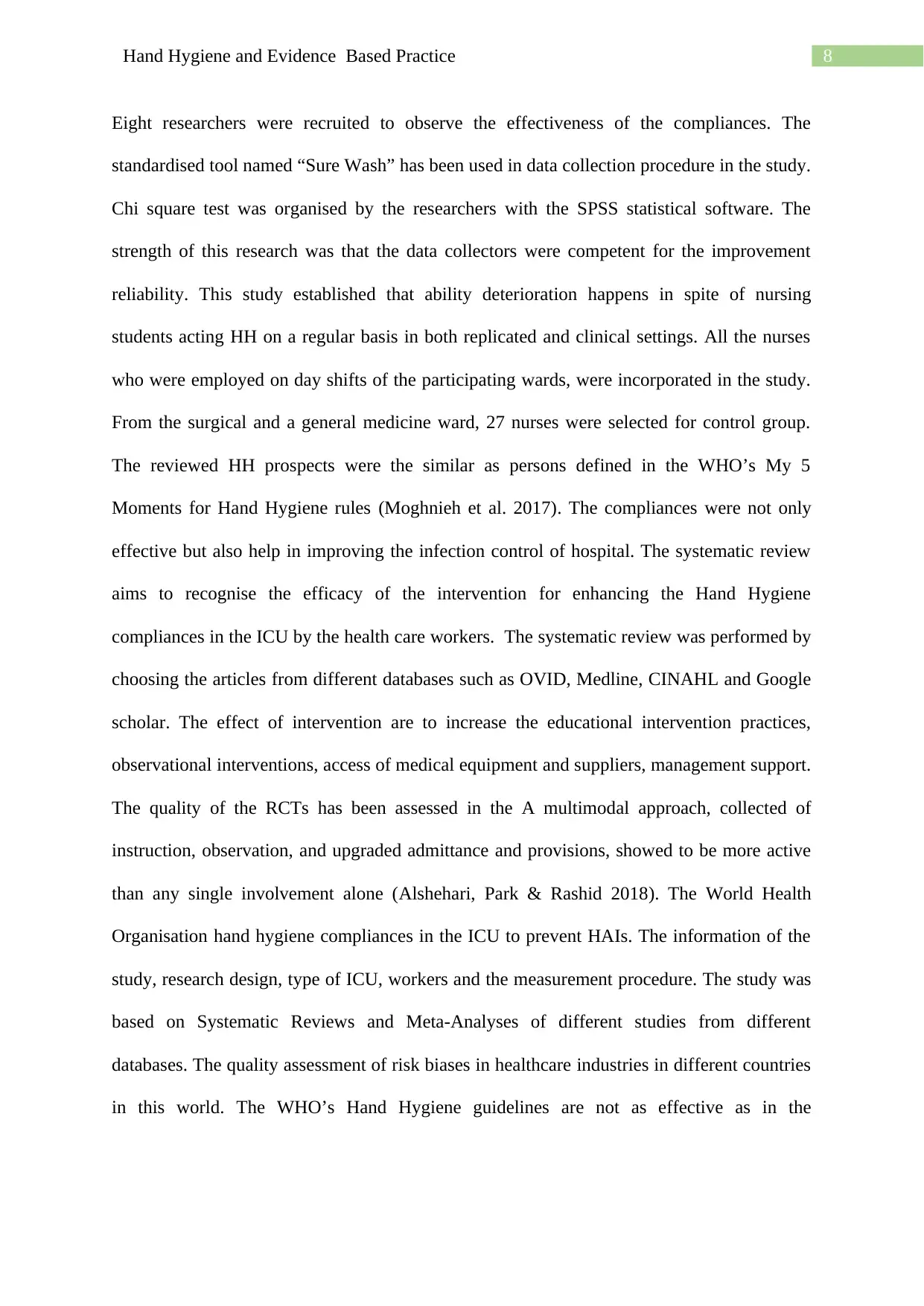
8Hand Hygiene and Evidence Based Practice
Eight researchers were recruited to observe the effectiveness of the compliances. The
standardised tool named “Sure Wash” has been used in data collection procedure in the study.
Chi square test was organised by the researchers with the SPSS statistical software. The
strength of this research was that the data collectors were competent for the improvement
reliability. This study established that ability deterioration happens in spite of nursing
students acting HH on a regular basis in both replicated and clinical settings. All the nurses
who were employed on day shifts of the participating wards, were incorporated in the study.
From the surgical and a general medicine ward, 27 nurses were selected for control group.
The reviewed HH prospects were the similar as persons defined in the WHO’s My 5
Moments for Hand Hygiene rules (Moghnieh et al. 2017). The compliances were not only
effective but also help in improving the infection control of hospital. The systematic review
aims to recognise the efficacy of the intervention for enhancing the Hand Hygiene
compliances in the ICU by the health care workers. The systematic review was performed by
choosing the articles from different databases such as OVID, Medline, CINAHL and Google
scholar. The effect of intervention are to increase the educational intervention practices,
observational interventions, access of medical equipment and suppliers, management support.
The quality of the RCTs has been assessed in the A multimodal approach, collected of
instruction, observation, and upgraded admittance and provisions, showed to be more active
than any single involvement alone (Alshehari, Park & Rashid 2018). The World Health
Organisation hand hygiene compliances in the ICU to prevent HAIs. The information of the
study, research design, type of ICU, workers and the measurement procedure. The study was
based on Systematic Reviews and Meta-Analyses of different studies from different
databases. The quality assessment of risk biases in healthcare industries in different countries
in this world. The WHO’s Hand Hygiene guidelines are not as effective as in the
Eight researchers were recruited to observe the effectiveness of the compliances. The
standardised tool named “Sure Wash” has been used in data collection procedure in the study.
Chi square test was organised by the researchers with the SPSS statistical software. The
strength of this research was that the data collectors were competent for the improvement
reliability. This study established that ability deterioration happens in spite of nursing
students acting HH on a regular basis in both replicated and clinical settings. All the nurses
who were employed on day shifts of the participating wards, were incorporated in the study.
From the surgical and a general medicine ward, 27 nurses were selected for control group.
The reviewed HH prospects were the similar as persons defined in the WHO’s My 5
Moments for Hand Hygiene rules (Moghnieh et al. 2017). The compliances were not only
effective but also help in improving the infection control of hospital. The systematic review
aims to recognise the efficacy of the intervention for enhancing the Hand Hygiene
compliances in the ICU by the health care workers. The systematic review was performed by
choosing the articles from different databases such as OVID, Medline, CINAHL and Google
scholar. The effect of intervention are to increase the educational intervention practices,
observational interventions, access of medical equipment and suppliers, management support.
The quality of the RCTs has been assessed in the A multimodal approach, collected of
instruction, observation, and upgraded admittance and provisions, showed to be more active
than any single involvement alone (Alshehari, Park & Rashid 2018). The World Health
Organisation hand hygiene compliances in the ICU to prevent HAIs. The information of the
study, research design, type of ICU, workers and the measurement procedure. The study was
based on Systematic Reviews and Meta-Analyses of different studies from different
databases. The quality assessment of risk biases in healthcare industries in different countries
in this world. The WHO’s Hand Hygiene guidelines are not as effective as in the
⊘ This is a preview!⊘
Do you want full access?
Subscribe today to unlock all pages.

Trusted by 1+ million students worldwide
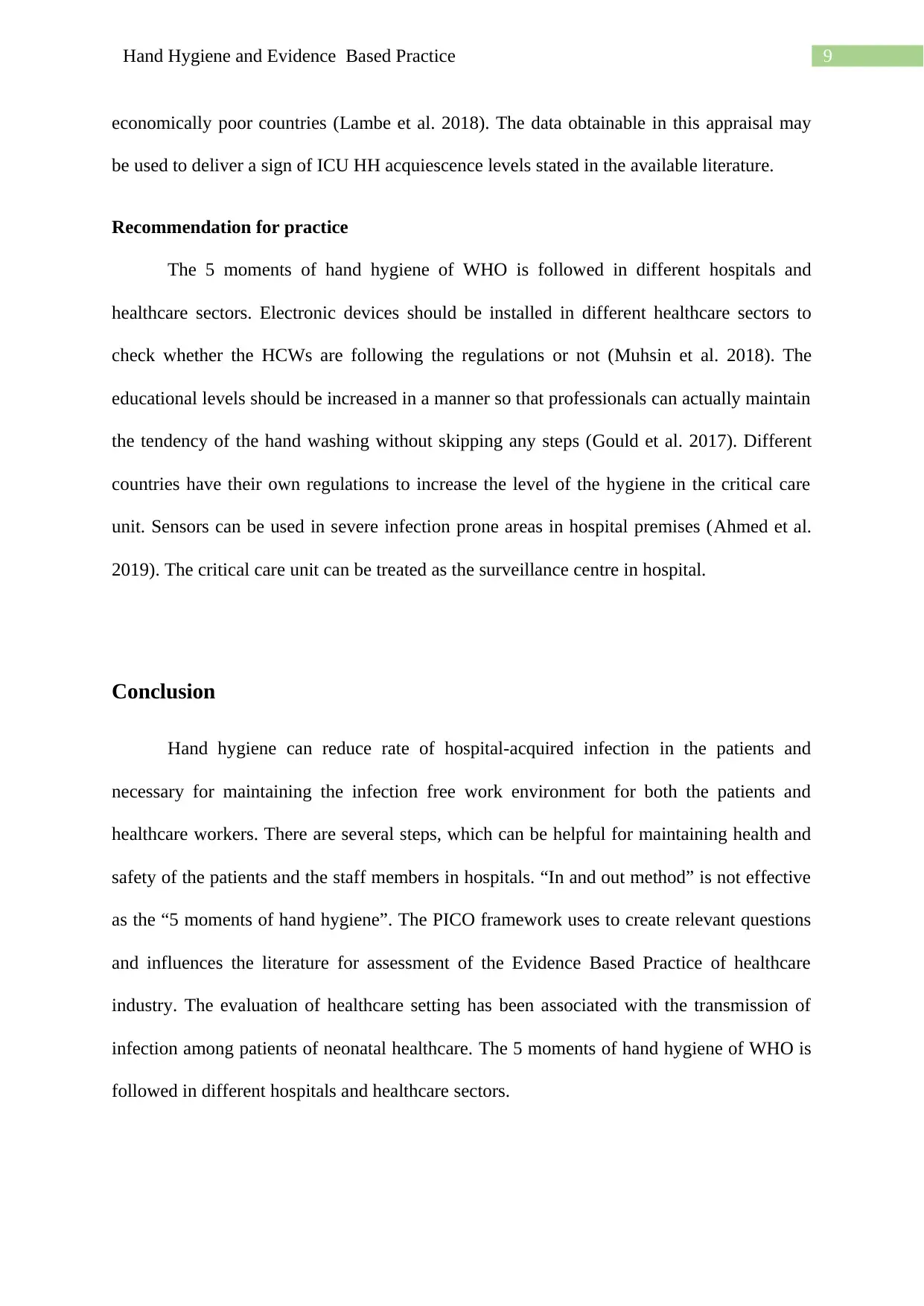
9Hand Hygiene and Evidence Based Practice
economically poor countries (Lambe et al. 2018). The data obtainable in this appraisal may
be used to deliver a sign of ICU HH acquiescence levels stated in the available literature.
Recommendation for practice
The 5 moments of hand hygiene of WHO is followed in different hospitals and
healthcare sectors. Electronic devices should be installed in different healthcare sectors to
check whether the HCWs are following the regulations or not (Muhsin et al. 2018). The
educational levels should be increased in a manner so that professionals can actually maintain
the tendency of the hand washing without skipping any steps (Gould et al. 2017). Different
countries have their own regulations to increase the level of the hygiene in the critical care
unit. Sensors can be used in severe infection prone areas in hospital premises (Ahmed et al.
2019). The critical care unit can be treated as the surveillance centre in hospital.
Conclusion
Hand hygiene can reduce rate of hospital-acquired infection in the patients and
necessary for maintaining the infection free work environment for both the patients and
healthcare workers. There are several steps, which can be helpful for maintaining health and
safety of the patients and the staff members in hospitals. “In and out method” is not effective
as the “5 moments of hand hygiene”. The PICO framework uses to create relevant questions
and influences the literature for assessment of the Evidence Based Practice of healthcare
industry. The evaluation of healthcare setting has been associated with the transmission of
infection among patients of neonatal healthcare. The 5 moments of hand hygiene of WHO is
followed in different hospitals and healthcare sectors.
economically poor countries (Lambe et al. 2018). The data obtainable in this appraisal may
be used to deliver a sign of ICU HH acquiescence levels stated in the available literature.
Recommendation for practice
The 5 moments of hand hygiene of WHO is followed in different hospitals and
healthcare sectors. Electronic devices should be installed in different healthcare sectors to
check whether the HCWs are following the regulations or not (Muhsin et al. 2018). The
educational levels should be increased in a manner so that professionals can actually maintain
the tendency of the hand washing without skipping any steps (Gould et al. 2017). Different
countries have their own regulations to increase the level of the hygiene in the critical care
unit. Sensors can be used in severe infection prone areas in hospital premises (Ahmed et al.
2019). The critical care unit can be treated as the surveillance centre in hospital.
Conclusion
Hand hygiene can reduce rate of hospital-acquired infection in the patients and
necessary for maintaining the infection free work environment for both the patients and
healthcare workers. There are several steps, which can be helpful for maintaining health and
safety of the patients and the staff members in hospitals. “In and out method” is not effective
as the “5 moments of hand hygiene”. The PICO framework uses to create relevant questions
and influences the literature for assessment of the Evidence Based Practice of healthcare
industry. The evaluation of healthcare setting has been associated with the transmission of
infection among patients of neonatal healthcare. The 5 moments of hand hygiene of WHO is
followed in different hospitals and healthcare sectors.
Paraphrase This Document
Need a fresh take? Get an instant paraphrase of this document with our AI Paraphraser

10Hand Hygiene and Evidence Based Practice
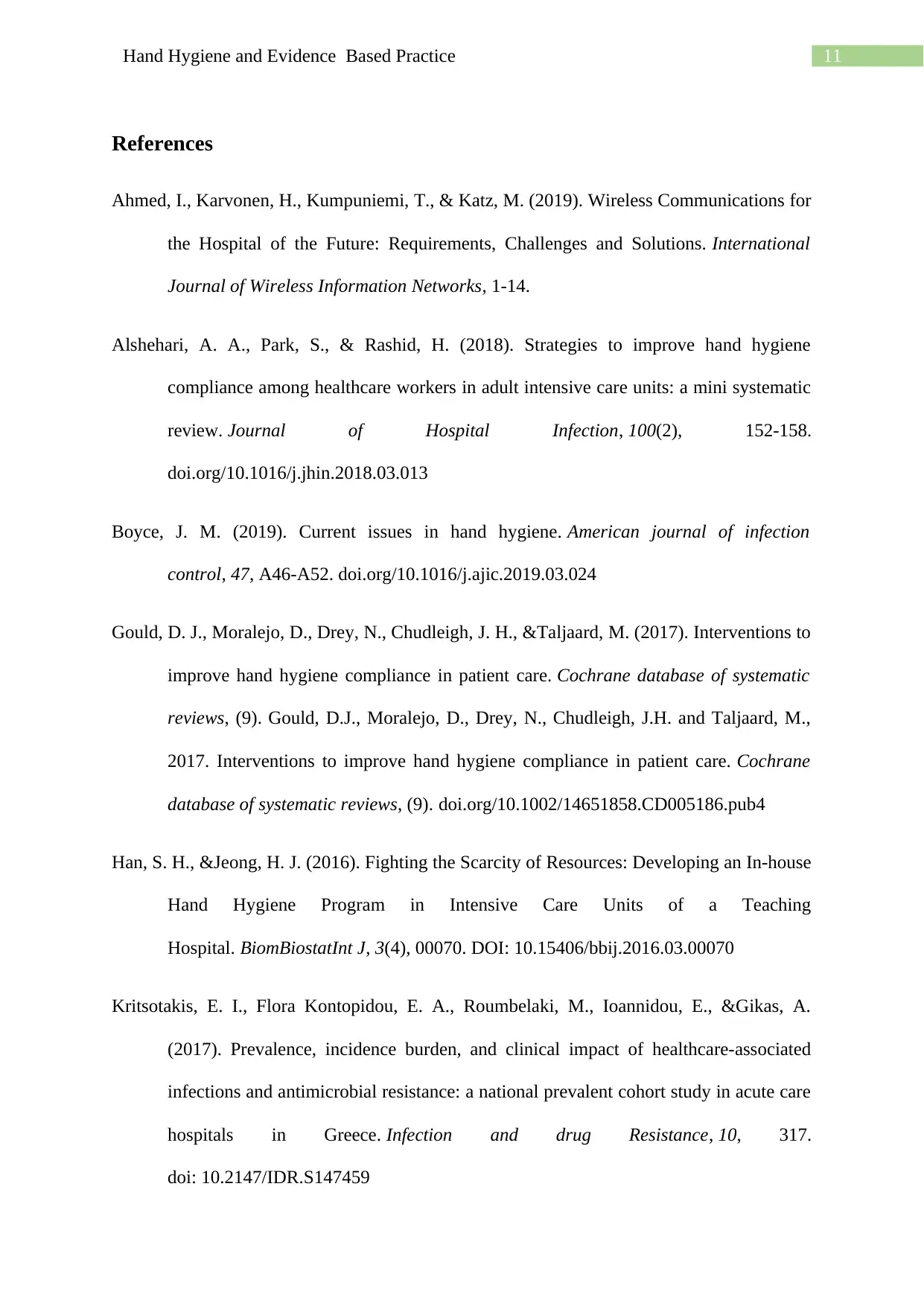
11Hand Hygiene and Evidence Based Practice
References
Ahmed, I., Karvonen, H., Kumpuniemi, T., & Katz, M. (2019). Wireless Communications for
the Hospital of the Future: Requirements, Challenges and Solutions. International
Journal of Wireless Information Networks, 1-14.
Alshehari, A. A., Park, S., & Rashid, H. (2018). Strategies to improve hand hygiene
compliance among healthcare workers in adult intensive care units: a mini systematic
review. Journal of Hospital Infection, 100(2), 152-158.
doi.org/10.1016/j.jhin.2018.03.013
Boyce, J. M. (2019). Current issues in hand hygiene. American journal of infection
control, 47, A46-A52. doi.org/10.1016/j.ajic.2019.03.024
Gould, D. J., Moralejo, D., Drey, N., Chudleigh, J. H., &Taljaard, M. (2017). Interventions to
improve hand hygiene compliance in patient care. Cochrane database of systematic
reviews, (9). Gould, D.J., Moralejo, D., Drey, N., Chudleigh, J.H. and Taljaard, M.,
2017. Interventions to improve hand hygiene compliance in patient care. Cochrane
database of systematic reviews, (9). doi.org/10.1002/14651858.CD005186.pub4
Han, S. H., &Jeong, H. J. (2016). Fighting the Scarcity of Resources: Developing an In-house
Hand Hygiene Program in Intensive Care Units of a Teaching
Hospital. BiomBiostatInt J, 3(4), 00070. DOI: 10.15406/bbij.2016.03.00070
Kritsotakis, E. I., Flora Kontopidou, E. A., Roumbelaki, M., Ioannidou, E., &Gikas, A.
(2017). Prevalence, incidence burden, and clinical impact of healthcare-associated
infections and antimicrobial resistance: a national prevalent cohort study in acute care
hospitals in Greece. Infection and drug Resistance, 10, 317.
doi: 10.2147/IDR.S147459
References
Ahmed, I., Karvonen, H., Kumpuniemi, T., & Katz, M. (2019). Wireless Communications for
the Hospital of the Future: Requirements, Challenges and Solutions. International
Journal of Wireless Information Networks, 1-14.
Alshehari, A. A., Park, S., & Rashid, H. (2018). Strategies to improve hand hygiene
compliance among healthcare workers in adult intensive care units: a mini systematic
review. Journal of Hospital Infection, 100(2), 152-158.
doi.org/10.1016/j.jhin.2018.03.013
Boyce, J. M. (2019). Current issues in hand hygiene. American journal of infection
control, 47, A46-A52. doi.org/10.1016/j.ajic.2019.03.024
Gould, D. J., Moralejo, D., Drey, N., Chudleigh, J. H., &Taljaard, M. (2017). Interventions to
improve hand hygiene compliance in patient care. Cochrane database of systematic
reviews, (9). Gould, D.J., Moralejo, D., Drey, N., Chudleigh, J.H. and Taljaard, M.,
2017. Interventions to improve hand hygiene compliance in patient care. Cochrane
database of systematic reviews, (9). doi.org/10.1002/14651858.CD005186.pub4
Han, S. H., &Jeong, H. J. (2016). Fighting the Scarcity of Resources: Developing an In-house
Hand Hygiene Program in Intensive Care Units of a Teaching
Hospital. BiomBiostatInt J, 3(4), 00070. DOI: 10.15406/bbij.2016.03.00070
Kritsotakis, E. I., Flora Kontopidou, E. A., Roumbelaki, M., Ioannidou, E., &Gikas, A.
(2017). Prevalence, incidence burden, and clinical impact of healthcare-associated
infections and antimicrobial resistance: a national prevalent cohort study in acute care
hospitals in Greece. Infection and drug Resistance, 10, 317.
doi: 10.2147/IDR.S147459
⊘ This is a preview!⊘
Do you want full access?
Subscribe today to unlock all pages.

Trusted by 1+ million students worldwide
1 out of 14
Related Documents
Your All-in-One AI-Powered Toolkit for Academic Success.
+13062052269
info@desklib.com
Available 24*7 on WhatsApp / Email
![[object Object]](/_next/static/media/star-bottom.7253800d.svg)
Unlock your academic potential
Copyright © 2020–2025 A2Z Services. All Rights Reserved. Developed and managed by ZUCOL.





